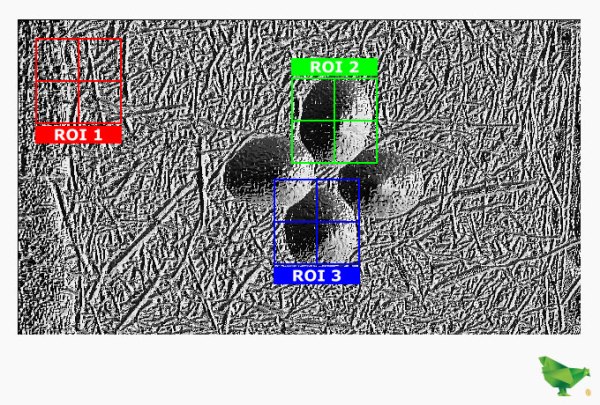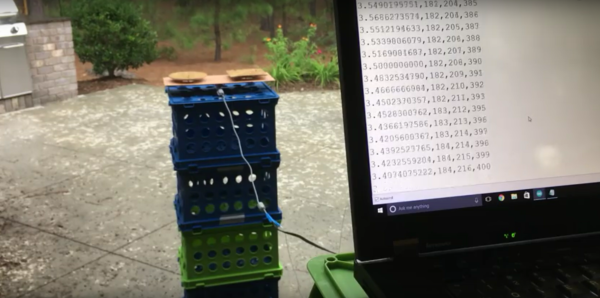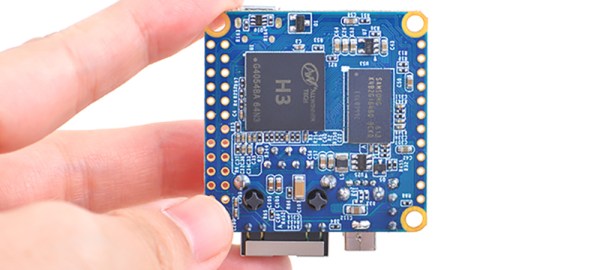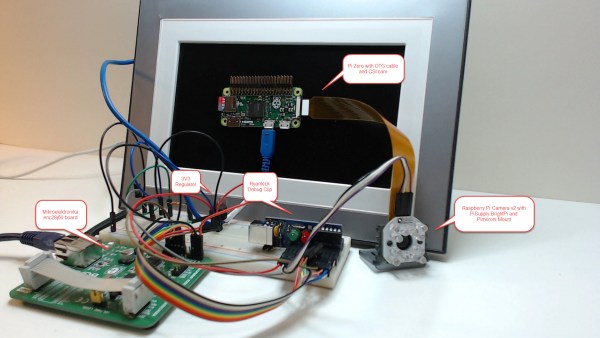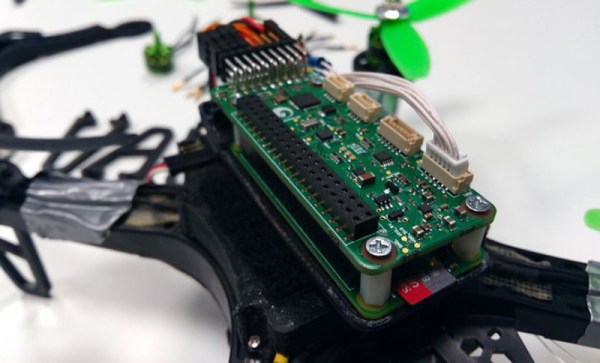You’ll have to dig out your French dictionary (or Google translate) for this one, but it is worth it. [Nicolas Giraud] has been experimenting with ways to use a webcam to detect the number of eggs chickens have laid in a chicken coop. This page documents these experiments using a number of different algorithms to automatically detect the number of eggs and notify the owner. The system is simple, built around a Pi running Debian Jesse Lite and a cheap USB webcam. An LED running off one of the GPIO pins illuminates the eggs, and the camera then captures the image for analysis.
Pi72 Articles
Rainy Day Fun By Calculating Pi
If you need a truly random event generator, just wait till your next rainstorm. Whether any given spot on the ground is hit by a drop at a particular time is anyone’s guess, and such randomness is key to this simple rig that estimates the value of pi using raindrop sensors.
You may recall [AlphaPhoenix]’s recent electroshock Settlers of Catan expeditor. The idea with this less shocking build is to estimate the value of pi using the ratio of the area of a square sensor to a circular one. Simple piezo transducers serve as impact sensors that feed an Arduino and count the relative number of raindrops hitting the sensors. In the first video below, we see that as more data accumulates, the Arduino’s estimate of pi eventually converges on the well-known 3.14159 value. The second video has details of the math behind the method, plus a discussion of the real-world problems that cropped up during testing — turns out that waterproofing and grounding were both key to noise-free data from the sensor pads.
In the end, [AlphaPhoenix] isn’t proving anything new, but we like the method here and can see applications for it. What about using such sensors to detect individual popcorn kernels popping to demonstrate the Gaussian distribution? We also can’t help but think of other ways to measure raindrops; how about strain gauges that weigh the rainwater as it accumulates differentially in square and circular containers? Share your ideas in the comments below.
Another Small Linux Computer With Pi In Its Name
Since the introduction of the Raspberry Pi, the embedded Linux scene has been rocked by well supported hardware that is produced in quantity, a company that won’t go out of business in six months, and a huge user base. Yes, there are a few small problems with the Raspberry Pi and its foundation – some stuff is still closed source, the Foundation itself plays things close to their chests, and there are some weird binary blobs somebody will eventually reverse engineer. Viewed against the competition, though, nothing else compares.
Here’s the NanoPi Neo, the latest quad-core Allwinner board from a company in China you’ve never heard of.
The NanoPi Neo is someone’s answer to the Raspberry Pi Zero, the very small and very cheap single board Linux computer whose out-of-stock percentage has led some to claim it’s completely fake and a media conspiracy. The NanoPi Zero features an Allwinner H3 quad-core Cortex-A7 running at 1.2 GHz, 256MB RAM, with a 512MB version being released shortly. Unlike the Raspberry Pi Zero, the NanoPi Neo features a 10/100 Ethernet port. No, it does not have PoE.
As with anything comparing itself to the Raspberry Pi Zero, only two things are important: size and price. The NanoPi Neo is a mere 40mm square, compared to the 65x30mm measurements of the Pi Zero. The NanoPi Neo is available for $7.99, with $5 shipping to the US. Yes, for just three dollars more than a Pi Zero with shipping, you get a poorly supported Linux board. What a time to be alive.
If you’re looking for another wonderful tale of what happens with cheap, powerful ARM chips and contract manufacturers in China, check out my review of the Pine64.
Hackaday Prize Entry: A Raspberry Pi Project
There’s no piece of technology that has been more useful, more influential on the next generation of sysadmins and engineers, and more polarizing than the Raspberry Pi. For $35 (or just $5), you get a complete single board computer, capable of running Linux, and powerful enough to do useful work. For the 2016 Hackaday Prize, [Arsenijs] has created the perfect Raspberry Pi project. It’s everything you expect a Pi-powered project to be, and more.
While the Raspberry Pi, and the community surrounding the Raspberry Pi, get a lot of flak for the relatively simple approach to most projects which are effectively just casemods, critics of these projects forget the historical context of tiny personal computers. Back in the early ‘aughts, when Mini ITX motherboards were just being released, websites popped up that would feature Mini ITX casemods and nothing else. While computers stuffed into an NES, an old radio, or the AMD logo are rather banal projects today, I assure you they were just as pedestrian 15 years ago as well. Still, the creators of these Mini ITX case mods became the hardware hackers of today. It all started with simple builds, a Dremel, and some Bondo.
[Arsenijs] takes his Raspberry Pi project a bit further than a simple casemod, drawing influence from a Raspberry Pi smartphone, a Raspberry Pi security system, a Portable Raspberry Pi, and a Raspberry Pi wrist computer. These are all excellent projects in their own right, but [Arsenijs] is putting his own special twist on the project: he’s using a Raspberry Pi, and a few Raspberry Pi accessories.
While this project is first and foremost a Raspberry Pi project, [Arsenijs] isn’t limiting himself to the platform with the Broadcom chip. The team behind this Raspberry Pi project was busy porting the project to Odroid when the Banana Pi came out. This changed everything, a refactor was required, and then the Orange Pi was announced. Keeping up with technology is hard, and is a big factor in why this Raspberry Pi project hasn’t delivered yet. You can say a lot of things about the Raspberry Pi foundation, but at least their boards make a good attempt at forward compatibility.
Already [Arsenijs]’ Raspberry Pi project is one of the more popular projects on Hackaday.io, and is in the running for being one of the most popular projects in this year’s Hackaday Prize. Whether that popularity will translate into a minor win for this year’s Hackaday Prize remains to be seen, but it seems for [Arsenijs] that doesn’t matter; he’s already on the bleeding edge of Raspberry Pi projects.
Pi Zero Digital Frame Kiosk Uses OTG Right
USB On-The-Go (OTG) is one of the fun aspects of the USB standard. There are feelings about the other aspects, but that one is alright. Regardless, [Francesco] realized one day that the £3 digital picture frames he purchased at a charity sale really didn’t care if the files on the thumb drive mysteriously changed all the time. It would just keep pulling and displaying the latest file at a blistering 0.2 frames per second. That’s right, the concept [Francesco] went after is to show changing data, even animations, with an update of one frame every five seconds!
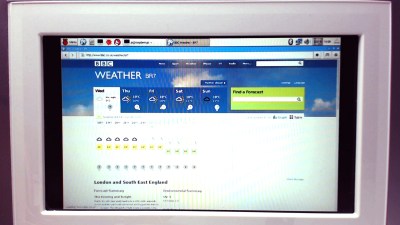 His initial tests showed good for the concept — the Pi can easily emulate a mass storage device, feeding in data whenever the picture frame looks for it. In addition to the Pi Zero board he added an Ethernet shield, a voltage regulator, a camera, and even some infrared LEDS. We suppose there are dreams for the future.
His initial tests showed good for the concept — the Pi can easily emulate a mass storage device, feeding in data whenever the picture frame looks for it. In addition to the Pi Zero board he added an Ethernet shield, a voltage regulator, a camera, and even some infrared LEDS. We suppose there are dreams for the future.
He has been developing scripts for this rig by logging in through a VNC. A cron job runs his scripts at regular intervals, grabbing useful data and making it available as an image. For example, one script opens up the weather in Epiphany (a web browser), takes a screenshot, and saves that screenshot to the mass storage being emulated using USB OTG. The digital picture frame blissfully updates, unaware of its strange appendages. Now the real limiting factor is how much you can accomplish with your mad Bash skills.
A Quadcopter Controlled By A Pi Zero
Flight controllers for quadcopters and other drones are incredible pieces of engineering. Not only do these boards keep an aircraft level, they do so while keeping the drone in one place, or reading a GPS sensor and flying it from waypoint to waypoint. The latest of these flight controllers is built on everyone’s favorite $5 computer, the Raspberry Pi Zero.
The PXFmini controller and autopilot shield is the latest project from Erle Robotics that puts eight servo outputs on the Pi, barometer and IMU sensors, a power supply, and all the adapters to turn the Raspberry Pi Zero into a capable flight controller. Since the Pi Zero will have some computational horsepower left over after keeping a quadcopter level, there’s a possibility of some very cool peripherals. Erle Robotics has been working with depth cameras and Lidar on more than a few drones. This makes for some interesting applications we can only imagine now.
The schematics for the PXFmini are open source in the best traditions of the RC and drone community and will be available soon. You can check out a video of the FXPmini flying around an office below.
Raspberry Pi Zero – Turning The Pi Into A USB Gadget, Over USB
[gbaman] has figured out a simpler way to program the new Raspberry Pi Zero over USB without modifying the board. Why is this useful? One example which appealed to us was setting the Zero’s USB port up as a mass storage device. Imagine plugging in your Pi powered robot, dragging and dropping a Python script into the mass storage device that shows up, and pressing a button on the robot to run the new script. Pretty fancy for $5.00.
You can get the PI to emulate a whole range of devices from a USB MIDI controller to a simple USB serial interface. We’re excited to see what uses people come up with. Unfortunately the Pi Zero is still out of stock most everywhere as we wait for the next production run to finish. Though if you’ve got one, why not check out a few of our thoughts and experiences with the device!
[gbaman] based his work off the work done by [Dave-0] and others over at the Raspberry Pi forums. [LadyAda] also has a version of this hack, which we covered, that involves soldering a header to the pi and using a UART adapter.
[via Hacker News]

